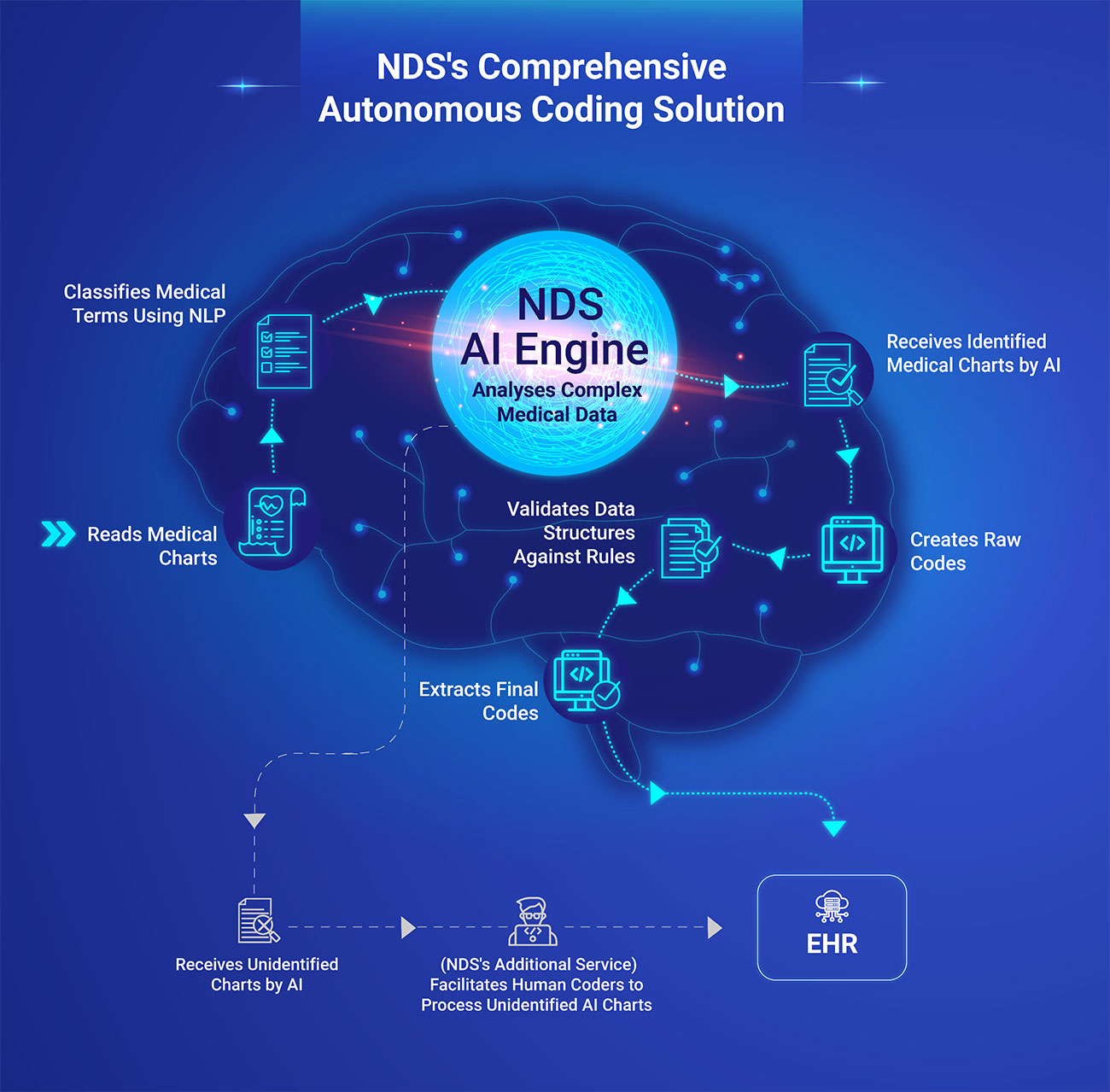The Ever-Evolving Landscape of Medical Coding
The landscape of Medical Coding in healthcare today is a dynamic and crucial aspect of healthcare administration and Revenue Cycle Management. Medical Coding plays a pivotal role in translating complex medical procedures, diagnoses, and services into universally recognized codes, ensuring accurate billing, insurance claims processing, and compliance with regulatory requirements.
With over 20 years of experience and deep expertise in healthcare Revenue Cycle Management, NDS understands the evolving challenges in the healthcare landscape. The field of Medical Coding is undergoing substantial changes due to technological advancements, shifting regulations, and the growing demand for precision and efficiency.
Challenges of Medical Coding Environment
Rising Labor Cost: The cost of employing Certified Medical Coders can be high. This is due to the specialized training and expertise required for accurate coding. As labor costs increase, healthcare organizations must find ways to balance cost-effectiveness while maintaining coding quality.

Shortage of Certified Coders: There is often a shortage of Certified Medical Coders in the healthcare industry. The demand for coders has increased with the growing volume of healthcare services, but there aren't always enough qualified professionals to meet this demand. This shortage can lead to bottlenecks in the coding process.
Slow Turnaround Time of Manual Coders: Manual Medical Coding can be time-consuming, especially when dealing with a large number of patient records. The manual review of clinical documentation, code assignment, and quality checks can lead to delays in the revenue cycle. This slow turnaround time can affect cash flow and reimbursement.
Unnecessary Denials from Coding Errors: Coding errors can result in a profusion of claim denials and delayed payments. These errors might include incorrect code assignments, missing information, or lack of specificity in clinical documentation.Such denials not only impact revenue but also require additional resources for claim appeals.
Lack of Reports and Analysis: Many healthcare organizations struggle with a lack of robust reporting and analysis tools to measure the performance of their coding operations. Without proper metrics and insights, it's challenging to identify areas for improvement, monitor coding accuracy, or assess coder productivity.
Remaining agile in a dynamic healthcare market with Autonomous Medical Coding
In the pursuit of overcoming persistent challenges and remaining agile in a dynamic healthcare market, while concurrently fostering revenue growth, the adoption of Autonomous Medical Coding as an integral component of your Revenue Cycle Management strategy stands as an indispensable and strategically sound decision. Integrating autonomous (or, AI-driven) coding into your revenue cycle in medical billing offers several compelling advantages that can significantly benefit your healthcare organization.

Here are some reasons why it's a great idea:
Reduced Labor Cost: Automating coding tasks can lead to cost savings by reducing the need for a large team of manual coders.This is especially beneficial in the face of rising labor costs associated with hiring and retaining Certified Coders.
Resource Efficiency: By automating routine coding tasks, you can allocate, or repurpose, your coding workforce to focus on more complex cases and exceptions where human expertise is essential. This efficient resource allocation can enhance overall productivity.
Enhanced Accuracy: Autonomous Medical Coding systems use advanced algorithms and artificial intelligence to accurately assign medical codes based on clinical documentation.This reduces the likelihood of coding errors and ensures that claims are submitted with precision. Enhanced accuracy leads to fewer claim denials and higher revenue capture.
Faster Coding Process: Autonomous Medical Coding systems can process large volumes of medical records and clinical notes rapidly. This speed accelerates the coding process, reducing the time between patient encounters and claim submission. Faster coding contributes to quicker reimbursement and improved cash flow.
Consistency and Compliance: Autonomous Medical Coding systems adhere to established coding guidelines and regulations consistently. This reduces the risk of non-compliance, audits, and penalties. Healthcare organizations can have confidence in the coding accuracy and adherence to industry standards.
Adaptability and Learning: Autonomous Medical Coding systems can continuously learn and adapt to changes in coding guidelines, regulations, and clinical practices. his adaptability ensures that coding remains up to date and compliant with evolving healthcare standards.
Real-time Feedback and Improvement: Some Autonomous Medical Coding systems (or, solutions) provide real-time feedback to Clinicians and Coders.This feedback loop helps improve clinical documentation quality, ensuring that coders have the information they need for accurate code assignment.
Advanced reporting and Analytics: Autonomous Medical Coding systems often come with robust reporting and analytics capabilities. These tools provide insights into coding performance, denial trends, and areas for improvement,enabling data-driven decision-making and the optimization of coding operations.
Scalability: As your healthcare organization grows, Autonomous Medical Coding systems can easily scale to accommodate increased coding demands without the need for significant additional resources.
For any healthcare organization aiming to seamlessly integrate Autonomous Medical Coding into their operational framework, the presence of a trusted and proficient partner is not just advantageous but absolutely vital. Such a partnership not only facilitates a smoother implementation process but also ensures the ongoing success and optimization of the Autonomous Medical Coding system (or solution).
NDS’s Autonomous Medical Coding Services - A Game Changer to Impact Your Revenue Cycle
We at NDS leverage advanced AI technology like Deep Learning and NLP to optimize processes, making them more cost-effective and efficient. Our expertise enables us to redesign, automate, and enhance your processes for improved speed and reliability.
NDS’s Autonomous Medical Coding Solution can be game changing for your Revenue Growth and here’s why.
Efficient Automation of Routine Tasks Requiring Human Coders: Autonomous Medical Coding streamlines operations by automating routine coding tasks, freeing up human coders to focus on more complex cases and decision- making.
Consistent Quality Leading to Reduced Errors: The automated system ensures coding quality consistency by reducing errors and compliance risks often associated with human variability.
Effective AI-Driven Code Assignment: Multiple AI engines swiftly identify discrete diagnosis and procedure values, leading to accurate and efficient assignment of ICD-10-CM and CPT codes and modifiers.
Speedy Chart Processing that Reduces Billing Delays: The system's rapid processing capabilities significantly outpace human coders, expediting the revenue cycle and reducing billing delays.
Exceptionally Lower Denials due to Coding that Decreases Administrative Burdens: By incorporating NCCI edits and payer rules, the system helps minimize claim denials, enhancing revenue collection and reducing administrative burdens.
AMA-Licensed Date Ensures Coding Compliance: Leveraging AMA-licensed data ensures coding compliance at the highest industry standards further mitigating compliance risks and boosting confidence in coding accuracy.

Choosing a Strategic Alliance to Achieve Operational Excellence
Having the perfect partner for Autonomous Medical Coding solutions within your Revenue Cycle Management (RCM) in Medical Coding is indispensable. Such a partner not only eases the integration of cutting-edge technology but also guarantees ongoing success and optimization. With their expertise, organizations can navigate the complexities of implementation, ensure coding accuracy, and remain agile in the ever-evolving healthcare landscape. This strategic alliance becomes the linchpin for achieving operational excellence, reducing errors, enhancing efficiency, and ultimately driving sustainable revenue growth in the healthcare sector.


